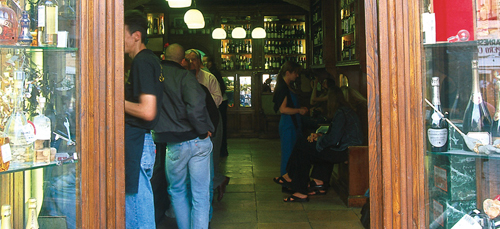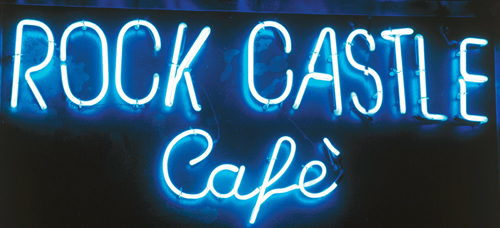Campo de’ Fiori to the Capitoline
This wedge-shaped area holds the dubious distinction of being the place where Caesar was assassinated – but it is also home to the Capitoline Hill, Rome’s finest glory right up to the present day. In ancient times, the zone was full of important public monuments, but in the 14th century, when the papacy moved to France, Rome sank close to extinction and it was along this bend in the river that the remaining 15,000 citizens huddled, in abject squalor. With the popes’ return, serious gentrification took place – papal palaces sprang up, long avenues were laid to connect them with the basilicas, and commerce thrived. Today, you can find clear signs of the long history of Rome’s most authentic neighbourhood.
The Jews in RomeSince the 2nd century BC, Jews have been a significant presence in Rome. They thrived throughout the Middle Ages, until, in 1556, Pope Paul IV, founder of the Inquisition, confined them to the squalid Ghetto, where they remained until 1870. Sixty years later they again suffered deadly persecution under the Fascists, but today Roman Jews are an integral part of civic life and number about 16,000. |

|
NOTE
Campo de’ Fiori
The “Field of Flowers” (see Campo de’ Fiori) occupies what was, in ancient times, the open space in front of the Theatre of Pompey. Since the Middle Ages, it has been one of Rome’s liveliest areas, a backdrop for princes and pilgrims alike. On the darker side, it was also the locus of the Inquisition’s executions, as attested to by the statue of the hooded philosopher Giordano Bruno, burned here in the Jubilee celebrations of 1600.
Campidoglio square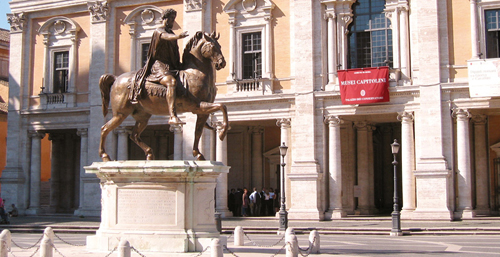
Campo de’ Fiori market
Capitoline Hill
The basic principle for comprehending Rome is that everything is built on top of something else. For example, the Capitoline was originally two peaks: one, called the Arx, graced by the Temple of Juno, and the other, the Cavo, with the Temple of Jupiter, now mostly occupied by the Palazzo dei Conservatori. The huge Tabularium (Record Office) was built between them in 78 BC, thus forming one hill, called the Capitol; and over that the Palazzo Senatorio was built in the 12th century.
Palazzo Senatorio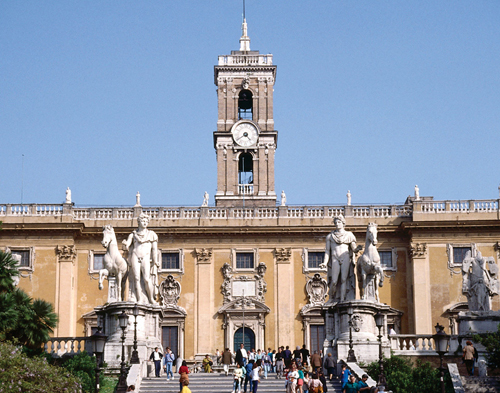
Largo di Torre Argentina
The important ruins of four Republican temples (one dating back to the 4th century BC) were uncovered here in 1925 (see Largo di Torre Argentina). On the northwest side is the pleasing façade of the 18th-century Teatro Argentina, with its inscription to the Muses. Many operas received their debuts here in the 19th century, including Rossini’s Barber of Seville. It was a crashing flop on its first night, but only because his enemy, Pauline Bonaparte, had paid a gaggle of hecklers.
Largo di Torre Argentina
Sant’Andrea della Valle
How could one of the most impressive 17th-century Baroque churches have been left with an asymmetrical façade? The answer is artistic temperament. Looking at the grandiose pile, it is quickly apparent that only one angel, on the left, supports the upper tier. Upon its completion, Pope Alexander VII dared to criticize the work, and sculptor Cosimo Fancelli refused to produce an angel for the right side. “If he wants another he can make it himself!” was his rejoinder to His Holiness (see Sant’Andrea della Valle).
Piazza di Sant’ Andrea della Valle
Open 7:30am–12:30pm, 4:30– 7:30pm daily
Free

Santa Maria in Cosmedin
Originally a bread distribution centre, the site became a church in the 6th century and, 200 years later, the focus of Rome’s Greek exile community. The Greek epithet “in Cosmedin” means “decorated”. Very little of the earliest ornamentation remains; most of it is from the 12th and 13th centuries, although there is a graceful altar screen characteristic of Eastern Orthodox churches. The most popular element, however, is the “Bocca della Verità” (“Mouth of Truth”), an ancient cistern cover. Legend has it that the mouth snaps shut on the hands of liars.
Piazza della Bocca della Verità 18
Open daily 9am–5pm (6pm summer)
Free
Santa Maria in Cosmedin
Foro Boario
The name refers to the ancient cattle market that was once here. Now the area is a mini-archaeological park, with two 2nd-century BC temples and a later Arch of Janus. If not for the ferocious traffic, it would be a wonderful place to linger. Dating from the reign of Constantine or later, the arch is unprepossessing, but the temples are amazingly well preserved. The rectangular shrine is to Portunus, god of rivers and ports, while the circular one is a Temple of Hercules.
Gesù
A windy piazza hosts the prototype Counter-Reformation church. Enormous and ornate, it’s meant to convince the wayward of the pre-eminence of the Jesuit faith. The façade is elegant, but the interior is the major dazzler – first impressions are of vibrant gold, bathed in sunlight. Then there’s the vision of angels and saints being sucked into heaven through a miraculous hole in the roof. The tomb of Ignatius, the order’s founder, is adorned with the world’s largest chunk of lapis lazuli.
Piazza del Gesù
Open daily 7am– 12:30pm, 4–7:45pm
Free
St Ignazio chapel, Gesù
Santa Maria in Aracoeli
The 6th-century church stands on the site of the ancient Temple of Juno Moneta (Juno the Sentinel), but it was also the Roman mint – and the origin of the word “money”. Superstition claims you can win the lottery by climbing on your knees up the 14th-century staircase leading to the unfinished façade – but what you will definitely gain is a fine view. Inside, the nave’s 22 columns come from ancient structures; the third one on the left is inscribed “a cubiculo Augustorum” (“from the emperor’s bedroom”).
Scala dell’Arca Capitolina 12
Open 9am–12:30pm, 2:30–5:30pm (to 6:30pm in summer) daily
Free
Santa Maria in Aracoeli
Fontana delle Tartarughe
The “Fountain of the Tortoises” is the work of three artists. First created in the late 1500s for the Mattei family, it was designed by Giacomo della Porta. The four bronze boys, however, were sculpted by Taddeo Landini. The crowning touch came almost a century later, when an unknown artist (some say Bernini) added the tortoises and gave the fountain its name (see Fontana delle Tartarughe).
Piazza Mattei
Fontane delle Tartarughe
Theatre of Marcellus
One of three ancient theatres in this district (see Theatre of Marcellus), dating back to the 1st century BC, and probably the most frequented of all Imperial theatres until the Colosseum captured the public’s favour. The lower archways once housed picturesque medieval shops, until cleared away by archaeologists in the 1920s. To the right of the theatre stand three columns and a frieze fragment that belonged to a Temple of Apollo, also from the 1st century BC.
Via del Teatro di Marcello
Open 9am–6pm (to 7pm in summer) daily
Roman Culture, Layer upon Layer
Because of church opening times, you should take this walk (two to four hours) starting at about 10am or at 4pm. Starting with the Theatre of Marcellus, notice the soaring buttresses that support the palace, added in the 16th century. Heading round the next corner, in Santa Maria in Campitelli use binoculars to espy the oak leaves depicted in the altar’s tiny icon. Continuing west, as you approach the Fontana delle Tartarughe, listen for the sound of splashing water echoing off the medieval walls. To the north, the Crypta Balbi Museum has fascinating displays about the neighbourhood’s history. One block north is the awe-inspiring Gesù.
For one of the best cappuccino-cornetto combinations in town, stop off at Bernasconi (Piazza Cairoli, 16).
At Sant’Andrea della Valle look up at the unusual barrel-vaulted ceiling. Then head south to Via di Grotta Pinta for the remains of the Theatre of Pompey . A block northwest, in the piazza of the Palazzo Farnese , admire the twin fountains, composed of stone tubs from the Baths of Caracalla. Walk across Campo de’ Fiori to Palazzo della Cancelleria to contemplate its Renaissance perfection.
End with a drink at La Curia di Bacco set in 1st-century BC vaults of the Theatre of Pompey.
Best of the Rest

Palazzo Farnese
One of Rome’s largest palaces is graced by superlative Michelangelo creations, such as the wonderful cornice (see Palazzo Farnese).
Piazza Farnese
06 686 011
Open by appt–call ahead to book
Adm
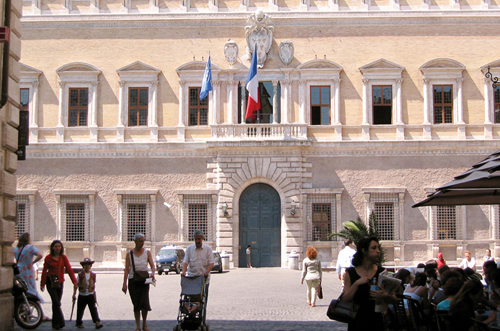
Palazzo Spada
Home in the 17th century to two brothers, Bernardino and Virginio Spada, who amassed a fine collection of paintings, the building now houses the Council of State and a gallery (see Palazzo Spada).
Piazza Capo di Ferro 13
Open 8:30am–7:30pm Tue–Sun
Adm
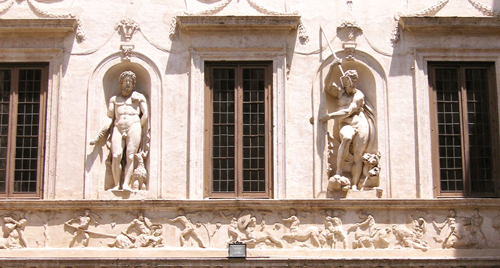
Palazzo Venezia
Pope Paul II, who built this palace, watched the carnival horse races from the balcony. From the same, Mussolini shouted his Fascist harangues (see Palazzo Venezia).
Piazza Venezia
06 6999 4318
Open 8:30am–7:30pm Tue–Sun
Adm
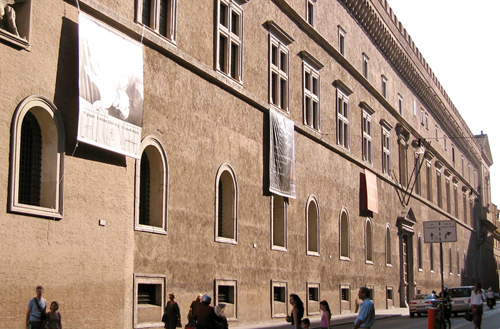
Portico d’Ottavia
Built in honour of Octavia, Augustus’s sister, this was an entrance to the Circus Flaminius. Despite the archaeological digs, you can pass through the ruins on scaffolding.
Museo Barracco
This palazzo houses a small but important collection of ancient sculpture (see Museo Barracco).
Corso Vittorio Emanuele II 166
06 6880 6848
Open 9am–7pm Tue–Sun
Adm
Synagogue
This 1904 synagogue has a museum that traces the history of Rome’s Jewish community (see The Jews in Rome).
Lungotevere dei Cenci
Open Jun–Sep: 10am–7pm Sun–Thu (until 4pm Fri); Oct–May: 9am–5pm Sun–Thu (until 2pm Fri)
Adm
Synagogue
Palazzo della Cancelleria
Sublime Renaissance structure, once the Papal Chancellery.
Piazza della Cancelleria
Open by appt only
Adm
Shops
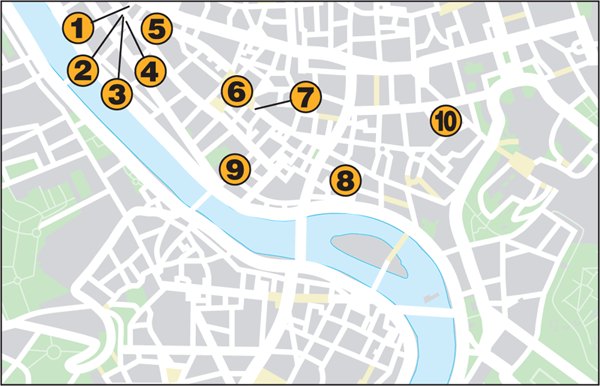
Marble and Tile Bottega
This is certainly one of the most fascinating of a nest of authentic workshops. Particularly appealing are the 18th-and 19th-century Neapolitan floor tiles.
Vicolo Cellini 16
Il Goccetto
Considered by connoisseurs to be Rome’s premier wine shop, more than 500 labels are available to try by the glass. The proprietor’s expertise is at your disposal when selecting which bottles to take home.
Via dei Banchi Vecchi 14
Antichità
One of the most appealing antiques shops on this street. An assortment of furniture and small knick-knacks at good prices.
Via dei Banchi Vecchi 47
Libreria Babele
Rome’s first gay and lesbian shop has a selection of books in English, plus information concerning goings-on about town.
Via dei Banchi Vecchi 116
Sciam
This incredible shop has a Middle Eastern bazaar atmosphere. Hand-blown glass is a speciality.
Via del Pellegrino 55
Fahrenheit 451
Cinema, art and photography books galore.
Campo de’ Fiori 44
Brooks
Modern classics for men in this little boutique, on the street known to have the best, most fashionable bargains in town.
Via dei Giubbonari 69
Momento
An eclectic boutique for just about every taste, with chiffon ball gowns, floor-sweeping wool coats and tops in wild prints, as well as a collection of funky and fun accessories.
Piazza Cairoli 9
Orologeria Mazzella
Looking for a nice watch that won’t blow your budget? This friendly proprietor sells name brands at about 30–50 per cent below regular retail prices. Strong on Swatch watches.
Via dei Pettinari 41
Libreria Rinascita
Once the Communist Party’s headquarters, this building now houses a well-stocked bookshop. Every Sunday one section of the store is entirely devoted to children, who are free to play and read.
Via delle Botteghe Oscure 1
|
Nightspots

The Drunken Ship
Currently the top spot, with a sea of energetic carousers night after night in this jumping piazza. Mainstream rock inside. Outside you queue at the service window to get your drinks.
Campo de’ Fiori 20–21
I Giganti della Notte
A newcomer to the Campo scene, but already a favourite with a young, good-looking crowd. Great outsize hi-tech decor and modern rock music inside; lots of tables and standing room outside.
Campo de’ Fiori 26
Taverna del Campo
Occupying as it does the crucial corner position, this lively drinking and gourmet eating establishment is always a winner and perpetually jammed with merrymakers. Tables inside and out.
Campo de’ Fiori 16
Caffè Farnese
A more chic place is hard to imagine. On a corner facing elegant Piazza Farnese, some of Rome’s smartest young beautiful people sip their glasses of wine at outside tables. Yet, it’s also really friendly.
Piazza Farnese 106
Sciam
A taste of Arabia awaits you here. A turquoise-glazed fountain splashes gently at the entrance, and inside all is inlaid wood and tiles. Teas and sweetmeats complement the dreamy music.
Via del Pellegrino 56
La Curia di Bacco
This long, narrow space is a vaulted corridor of the ancient Pompey’s Theatre.
Via del Biscione, 79
Mad Jack’s
A classic Irish pub offering all the brews you can imagine, especially Guinness, along with decent light snacks.
Via Arenula 20
Shanti
An Arabian night out: hookah pipes, exotic teas, live music and belly-dancing.
Via dei Funari 21
Roman-Jewish Restaurants

Da Giggetto
Famous for its first-rate cookery and grand setting, right next to the soaring columns of the Portico d’Ottavia. Try chicory shoots (puntarelle) with anchovy dressing, a typical Roman dish.
Via del Portico d’Ottavia 21a–22
06 686 1105
Closed Mon

La Taverna del Ghetto
Kosher cooking in remodelled medieval rooms, or outside on the piazza. Grilled fish is their forte.
Via Portico d’Ottavia 8
06 6880 9771
Closed Fri D
Sora Margherita
Wonderful Jewish-Roman delicacies. No sign; look for the red streamers in the doorway. Weekday lunches only.
Piazza delle Cinque Scole 30
06 686 4002
No credit cards
Zi Fenizia
A pizzeria and a Jewish café all rolled into one outlet.
Via dell’Umiltà 31
349 252 5347
Closed Fri D, Sat
No credit cards
Filetti di Baccalà
A Roman tradition, little changed for centuries. Juicy fried cod fillets, served with similar Roman standards.
Largo dei Librari 88
06 686 4018
Closed Sun
No credit cards
Da Sergio alle Grotte
A simple, traditional Roman dining experience: spaghetti alla carbonara, gnocchi, tripe and more.
Vicolo delle Grotte, 27
06 686 4293
Closed Sun
Osteria ar Galletto
An old favourite, tables spilling out into the piazza every summer. Good, honest cooking.
Piazza Farnese 102
06 686 1714
Closed Sun
Yotvata
Kosher cuisine in a historic palazzo. Good for pizza, fresh fish and hearty pasta dishes. Excellent desserts.
Piazza Cenci 70
Closed Sat L, Fri D
|





